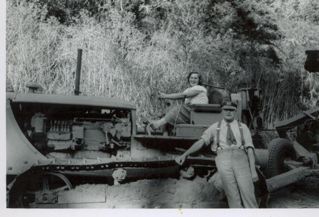From the Half Moon Bay Review, Oct. 19, 1950
Story by Gino Lea 
“This Is Your Coastside; Its People, Places and Industries”
“Galen Wolf–Part I
“Galen Wolf long ago discovered what most of us spend a lifetime futilely seeking–a pleasant way of life. It is the essence of this gentle man’s existence and his work.
“If you like interesting people, you would like Galen Wolf. He’s a sharp featured, loose jointed man flirting with his early sixties and standing just beyond medium height. He has the square jaw and jutting chin usually associated with a fighter, and a wide generous mouth that lends itself easily into a humorous smile.
“His small alert blue eyes are made to appear smaller and more deeply set by their conditioning to be heavily lensed glasses he wears. A bandanna or large handkerchief covers his head, a smooth expanse of skin, except for a fringe of snow white hair, which has little in common with a comb. The ends of the bandanna re rolled up into a beret like affair, which is held in place by the straps of green eyeshade Galen usually wears over it. The combination actually amounts to a homemade cap that is cool, comfortable, and restful.
“He’s slightly stoop shouldered from his constant hunching over his sketches and paintings, but he sits and stands with the relaxed ease of an athlete. It is a poised sort of relaxation whose nature is primarily mental, whereas the conditioned athlete’s is almost purely physical. It is the man’s inner harmony that seems to manifest itself in a physical sense.
“There is something singularly [missing words] complete to sweater and tie, are well worn and loose fitting and yet are in no way casual or sloppy. Rather there is an exactness about them, even to neatly knotted loose fitting tie, that suggests a precise and orderly but tolerant mind. Clothes have a way o losing their identity on Galen. Regardless of what clothes he wears, it is only a matter of time until they become part of him, merely one phase of his personality.
(Photo: Galen Wolf with a friend on the tractor.)
“There’s an unpretentious sort of dignity about him that combines the worshipful simplicity of a man’s love of nature and land with the added refinements of the cultured mind of an underpaid college professor.
“Everything that Galen is–a pleasant, cultured man of simple dignity–is reflected in his art.
“Galen Wolf is one of the foremost watercolor artists in the state, and certainly the ablest interpreter of Coastside scenes. He has had a traditional show of country pictures at the Peninsula Book Store in Burlingame for 8 years, plus one show at the Mull Galleries on Sutter Street. He has had pictures on exhibit at Grave’s and Maxwell’s, Allied Arts in Palo Alto; at the California Historical on Mission.
“Galen estimates he has sketched and painted over 400 Coastside scenes, mostly farmsteads, which are his favorite subject.
“He has also at one time or another done all the California Missions. Two of his water color paintings, one of Mission Dolores in San Francisco and one of Mission San Luis Rey de Frances at Oceanside, appeared in the Rotogravure sections of the March 28, 1937 issue of the San Francisco Chronicle. They were part of a unique set of 21, painted by Galen, representing all of the California Missions as they appeared about 1880 when an accurate set of photographs was made by Horace Tibbets o the Southern Pacific. Galen’s paintings were the products of a close study of those photographs supplemented by a long study of each of the Missions as they appeared at the time he painted them.
“Galen has also done some 70 scenes of the Sierra mountains and lakes.
“A short time ago, in conjunction with one of the shows, Galen had a booklet printed which proved to be immensely popular. It provided the background and history of his paintings. It was entitled COASTLAND, and he described it as a short story telling of the vistas and doings of a pleasant land. It was a poetic account of the four acres that have enriched the customs of this Coastside since the Indian times.
“The first to come were the Spanish with their musical names: Miramontes, Vasques, Guerrero, Vallejo, Castro and Gonzales.
“Then from across the mountains came the Scotch and the Irish–the Campbells, Fillmores, Griffiths, Higgins, Bordens, and Graingers. Samuel Walker and Rufus Hatch. Coburn, McCormack and Steele at Pescadero, Cowell and Dobbel at Purisima.
“Then down across the sea came the Azore Islanders from Ponta Delgada and Portuguese from the Mainland. With them a reverent faith and a new custom, and a tradition of Thanksgiving older by then the Pilgrims–Chamarita.
“And finally a fourth migration, the Italians with their new techniques of farming who turned pasture lands into grey-green artichoke fields. Sprouts, peas and sugar beets followed.
“These nationalities with their gay customs and traditions and their culture brought with a way of life that was slow, gentle and rich. People change but the land does not. The streams, the countless valleys, the secluded beaches, the mountains and the sea. Their beauty remains a constant thing. It is that beauty Galen endeavors to capture.
“Remarkably enough, it wasn’t until 1935, when Galen was in his 40s, that he took to painting seriously. He had come to know by then that it was what he wanted, the only thing he could be happy at. So at an age when most men are beginning to think of security, Galen ventured into a new world and life.
“Galen began developing his artistic talents at the age of twelve. He was taught sketching and painting by Gertrude Boyle, a friend of the family and a prominent sculptress, who, in his time, made busts of most of the California notables, including John Muir, Joaquin Miller, Jack London [words missing.] He studied with her off and on until he found the opportunity to make painting his life’s work. In the interim, he spent 30 years in farming activities in the San Joaquin Valley. As a mechanical engineer he worked his way through a variety of jobs–superintendent of a 2,000-acre farm, advisor in the selection of crops for planting in different types of soil, and activity in the water districts and the legal squabbles that ensued. Galen was the first man to process hemp in the San Joaquin Valley.
“All through these years painting remained Galen’s first love. Had he been able to, he would have made the transition much sooner but family responsibilities deterred him from devoting more than part time to his painting. At that he managed to spend a year touring Europe, in 1905, mostly the middle part, to learn what he could of art in a land that inspired the masterful works of the world’s finest artists. It was a general tour intended to absorb te culture and history of htis rich land. At the same time he made special note of the watercolor techniques in England, France, Italy and Greece. Galen resturned to this country immeasurably enriched by his experience. It is a pilgrimage he believes every man or woman should make once in their lives. Unfortunately it is the nature of man that he is limited by his intelligence as to the things he can understand and appreciate. The average man could tour Europe for ten years and never see what Galen saw in one. There are some forms of beauty and culture that are reserved for the aesthetic eye and soul of an artist or poet. The average person lives and dies without ever being touched by it.
“It was no accident that Galen chose watercolor as his form of art. He chose it because he prefers to paint to express an antidote to the grimness of life. His watercolor technique makes that possible through little picture that register quietly and pleasantly. It is a medium of expression that is spontaneous and refereshing where oil technique is too heavy, intense, and forceful.
“Water coloring is a fluid action which once begun can’t be left alone. It is a semi-struggle for the artist because it presents a constant challenge to his ability to discipline and control it. Usually 2 or 3 hours of concentrated activity is all Galen will attempt in any one day. Any attempt to work beyond that is likely to result in inferior work. His technique suffers by it, so does his approach and perspective.
“How well or badly you paint isn’t important. Involvement in painting is the important thing, according to Galen. If a man can lose himself completely in a painting so that he has no awareness of time, or of physical sensations he achieves the ultimate in emotional experience. Art as such is religion. The man who loses himself for a few hours in the purity and beauty of its emotion and expression [words missing.]
“To get away from the constant struggle with watercolors, Galen occasionally turns to pastel work for relaxation. Pastel painting is done with the deliberate vigorous stroking of the French Impressionists. But it, too, is a nice quiet approach to pictures.”

